Sekowo has a long history reaching back over two-thousand years, frought with changes and occasional major conflicts. The territory of Sekowo was first unified in 175 CE under the Orinco Tsekwon Empire. Between 1299 and 1560, Sekowo was a part of the Empire of Gao-Soto, and during the early modern age, it was successively colonized by Egelion and Rildanor. After gaining independence in 2193, Sekowo experienced several centuries of instability, dictatorship, and war, until the Modern Era, believed to have started in 2440. This era saw unprecedented development, stability, and expansion, until the collapse of Sekowo after the 30th century wars. Since then, Sekowo has been reduced to a struggling third world state. Although Sekowo managed to recover some of her lost prestige by slowly retaking control over the lost Sekowan colonies, this was ended with the Indralan-Sekowan War, which also put an end to the Sekowan colonial empire.
Pre-Colonial Sekowo[]
Sekowo has been the cradle of some of Dovani's most original and advanced civilizations, but unfortunately much of the historical evidence about the period before 200 BCE has been lost. However, archaeologists have been able to determine that the first human settlers in this area were several groups of nomads calling themselves *Shineyalane'es or *Shinyalane'es that came from the east around the 2nd millennium BCE. Many of them settled down in the southern region around Carcosa, and were the ancestors of the Shinjalan people.
The Shinjalans were a large and diverse group of ethnicities, inhabiting most of the western coast of Dovani, and they were the creators of a rich culture, one of the oldest and most original in Dovani. Around 800 BCE the Shinjalan tribe of Orincos began to colonize much of Dovani's West coast. Around 300 BCE the Orinco civilizaion reached its golden age. They excelled in literature, philosophy, historiography, architecture, natural science and many other fields of human knowledge. The Orincos were organised in city-states, the most notable being Carcosa, Lik'in, and Kuzacotl. In 175 CE, the king of Carcosa, Pacal the Great, unified most of what is now Sekowo in an empire, which lasted several centuries and formed the basis of a unified pre-colonial Sekowan culture. The ancient Orinco language, Tsekwon, became the lingua franca of the areas east of the Barrier Range.
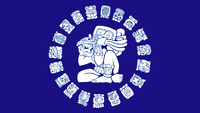
The Flag of the Tsekwon Empire
After the fall of the Tsekwon Empire in 589, the territory of Sekowo became divided into many small feudal kingdoms, the most important being Ro'ndum (Hasowar and Undarro, with the capital at Kuzacotl) and Bisonem (Bizena and Lorrod, with the capital at Lik'in), while the Orinco city-states managed to regain independence. In 1299 most of Sekowo was conquered by the Empire of Gao-Soto, and the Kunihito thus became the dominant cultural group in Sekowo.
With the fall of the Empire of Gao-Soto in 1560, the territory of Sekowo was divided in several Gao-Showan kingdoms and Orinco city-states, which were reunified in 1616 by the Kunihito-led Kingdom of Sekowo under the Mō Dynasty.
In 1657, the first Selucian explorers, led by Carolus Almerius, reached what is now Sekowo. Almerius returned the following year with a party of explorers and conquisitatores, under a mission from the Prince of Assedo to establish an Assedan foothold in Dovani. The Assedans entered various trade agreements with the Mō Kings and established colonial factories on the coast.
The Colonial Period[]
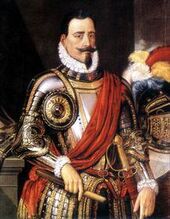
Carlos Almerius, the first Captain General of the Captaincy General of Sekowo and Bissonium
In 1682, after a failed native revolt against Assedo's presence, the Assedans forced the Kingdom of Sekowo to become a protectorate of Assedo while retaining the local monarch. Thus the territory of Sekowo was reorganized as a protectorate under the Captaincy General of Sekowo and Bissonium, being effectively conquered by the Principality of Assedo. At the same time, The Anantonese Empire opened a trade port in Southern Seko near modern day Eiwa, Nanzan Prefecture, and used this city as a trade entrepot to connect Dovani to Selaya. Ananto never attempted to colonize Seko, however, and merely sought to exploit resources of the nation for its growing maritime empire. Instead, Ananto governed through local leaders, and left existing culture largely in tact.
Anantonese political and economic influence increased as colonial competition world wide began intensifying. By 1860, the Anantonese Government had established effective Administrative control over all of modern Seko, removing the King of Sekowo and governing the entire colony directly. But soon after, parts of the colony began breaking away. A successful anti-colonial rebellion in 1863 restored the monarch of the Kingdom of Sekowo, Mō Sei, to the throne in modern day Hokuzan and the northern two thirds of the modern Tozan Prefectures. That kingdom was short lived, however, and it soon came under the control of an expanding Selucian Republic, with Mō Sei becoming a client king under Egelion Viceroys. Meanwhile, peace in what was left of the Anantonese Colony of Western Dovani (modern Nanzen, Kankawara and Sanko Prefectures, as well as the southern third of Tozen Prefecture) was always tenuous. Regular rebellions prevented Kalistan from ever fully consolidating their control over Anantonese Western Dovani. Following a successful blockade of Anantonese ports by The Holy Luthori Empire, the Anantonese abandoned Seko entirely by 1907. At this point all remaining Anantonese controlled lands were transferred to newly independent Egelion.
The King of Sekowo was retained on the throne until 1875, when Mō Sei was forced to abdicate, and Sekowo was reorganized as a Province, ruled by a Propraetor. In 1898 the Province was upgraded to a Proconsular province. Like Drania, Sekowo was under the unofficial control of the Selucian colony of Egelion. During the colonial era Selucians settled Sekowo in large numbers. At first Selucian settlers largely originated from Egelion, but later many more settlers from Canrille arrived, in time leading to the emergence of the Sécowonnais people. During the Proconsular Province of Sekowo, although the economy of the South was still based on slave-fueled cultivation of large plantations, the North saw significant economic development. What is now Hikhala and Bizena was covered by trade routs towards independent Hulstria, and the existence of rich forests provided incentives for fur trading. Consequently, the north of Sekowo became the most urbanized, and later most industrialized, part of the country.
As a result of the North Seleyan Wars Egelion gained its independence from Selucia in 1905, and immediately staked its claim to the Selucian colonies of Drania and Sekowo. Having also lost its southern colony of Lourenne, Selucia was forced to agree to Egelian rule over its former colonies in northern Dovani. During direct Egelian rule, the Sécowonnais land-owners entered numerous conflicts with the representatives of the central government. One such conflict began in 2190, when the creole-based elite, led by Filliam H. Muffman, protested against several new taxes imposed on the colonists, the fact that they were not represented in the national Parliament, and the recent attempt of the royal government to abolish slavery in all colonies.
The Independence and the Union[]
The protesters soon realized that the metropolitan government was unwilling to respect their wishes when a large Selucian fleet carrying armed soldiers landed in Kroton. The colonists gathered in the city of Pelias and on February 1st, 2193 they declared Sekowo an independent and sovereign nation under the name of the Union of Sekowo (Unión de Sekowo). Because the creole colonists were very few, not more than a few tens of thousands, they were unable to form a large army by themselves, so they recruited Sekowan slaves, but refused to pay them any levies. The Sekowan army was therefore very weak, despite its considerable size, and lost several important battles, such as he battle of Katanus (2194). After several slave rebellions, the Criollos were forced to promise the emancipation of all slaves. The Sekowan army was reorganized and managed to win the decisive battle of Aragonion. The first President of the Union of Sekowo, Filliam H. Muffman of the Filliam H. Muffman Party, was elected in 2196. When the Cabinet Proposal of 2198 passed, the Liberal Conservative Party was greatly annoyed to be left out of the cabinet. Kyle Martin vowed to repay the snub. In 2200 there was a sudden spate of resignations. Rumors abounded that threats by the Liberal Conservative Party were behind the resignations.

Flag of the Union of Sekowo
The 23rd century was a very turbulent moment in Sekowan history, with many successful or atempted coups d'etat, political assassinations and civil wars. In 2249 Kafuristani troops landed on Sekowan soil wishing to invade the country, and on the 13th of January 2250 the Sekowan legislative unanimously declared war on the United Majatran Republic of Kafuristan. The war was short but very difficult, and the inferior Sekowan military used popular support to reject the invasion using guerilla tactics. The war, which was caused by the alleged presence of secret Kafuristani training bases in Sekowo, was very costly for both sides.
The Aretist Period[]
In 2402, Sekowo was brought under the control of Aretist parties, who renamed the country as the Aretic Archonate of Sekowo. Sekowo was than restructured as a feudal, agricultural nation subjugating the people, or Dema, under the rule of the bureaucratic caste, the Acolya, and the spiritual and political leaders of the state, the Avatara. Sekowo's western plains were converted into massive plantations harvesting Flavian, and the the state's investment in defense hardware led to the rise of a large industrial base in the south. When the Aretist movement first came to power in 2402, a massive cultural and economic change was initiated intended to bring the country under strong Aretist sway. The installation of the power system was not ideal and The Avatara became absolute rulers through manipulation of the monetary and military resources of the nation. During the transition from Solentia to Sekowo, the brightest and most ambitious Acolya were purged from the movement. The modern Acolya were mere servants and the Dema was insignificant.
The decade-long civil war which began in 2406 was one of the bloodiest and ideologically-charged in Terran history. The instability was not the fault of two competing sides, but many separate factions which came and went during this turbulent period. Some 1.4 million are thought to have died as a result of the chaos and carnage, and the infrastructure of the nation was greatly damaged.
The Fall of Aretism[]
By the 2430's, following the civil war and popular hatred for Aretism the Aretic government has gradually been losing influence to both groups on the political left and right. The official end of the Aretic era was 2436, thirty-two years after its inception.
The Modern era officially started in 2440 with the Federal legislative elections, marking the beginning of several decades of peace.
Second Sekowan Civil War[]
Following sixty years of peace Sekowo was for the second time in a state of civil war.
The war was based almost completely on the opposing ideologies of the liberal conservative rightist parties and the Socialist and Communist leftist parties, though the issue of secularism formed a significant undercurrent to the conflict.
The war, considerd to be one of the least violent in modern Terran history saw only one battle, fought between Islamist militatns from a sympathetic Al'badaran party and the APP.
The First Commonwealth[]
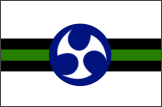
The Sekovia, Sekowo's most used flag, dates from the First Commonwealth
The First Commonwealth era is considered to have started in the year 2440, though Sekowo did not use Commonwealth in it's name until several decades after this. The era is one of the longest and encompasses great political change, civil and external war and the growth of Sekowos territory to its modern size. It was during the 25th and the 26th centuries that Sekowo established most of its colonies
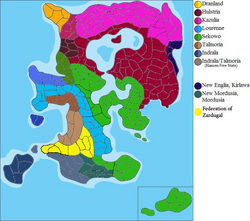
Sekowo at the height of its power during the First Commonwealth and First Empire
. It was also at this time that the Ishida Dynasty, originally a political dynasty within the Democratic Socialists Party, began to rise to prominence.
The First Empire[]
The Commonwealth era officially ended in 2723 as a result of the massive change in the government from a semi-presidential Federation into a Federal monarchy, the First Sekowan Empire. In 2723, following the passing of the 'Empire Bill' Sekowo officially became a Monarchy, however, while the Ishida Dynasty was considered at the time, it would be the House of Reynard that would take hold the position of Imperial Family. In 2852, following the 'Imperial Family Bill' the Ishida Dynasty became the Official Imperial House of Sekowo.
It was during this time that Sekowo lost all of its colonial possessions, having sold them in March 2874 to the Holy Luthori Empire and March 2875 to the Federation of Zardugal. This action was contested at the time, because the territories sold were officially States of the Empire, and although the selling of the protectorates was overturned by later governments, they remain under foreign occupation, a cause of much vexation to Sekowan nationalists.
The Second Commonwealth[]
In November 2891 after months of internal political conflict and tension, a semi-presidential parliamentary democracy was created unanimously by the Senate, under the title of People's Democratic Republic of Sekowo. The government of the time set its goal to regain the respect Sekowo once had before its former government collapsed. In 2907 Sekowo was officially renamed as the Commonwealth of Sekowo, and in 2910 the Federal Commonwealth of Sekowo. During this period the government was greatly decentralised, and the unions gained much political power. The Federal government attempted to regain from Hulstria some of Sekowo's lost colonies, but this offer was rejected. It was also during the Second Commonwealth that ethnic tensions and radical nationalism began to rise politically.
The Second Empire[]
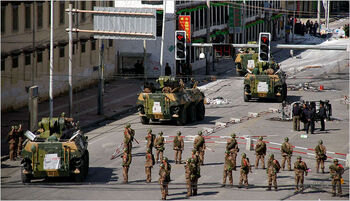
Imperial troops liberating Rhodon from Communist rebels
The radicalisation of Sekowan politics during the last years of the Federal Commonwealth, coupled with a severe fiscal crisis, finally led to the demise of the Commonwealth. Following a brief civil war, the Ishida Dynasty again gained power in February 2925, with the ascent to the throne of Yukio Ishida and the creation of the Eternal Harmony and Empire Magnificent of Sekowo. This last period is also marked by the intensification of ethnic conflict, and was almost entirely covered by civil war. In January 2935 an Orinco Junta seized power in a coup d'etat, and, due to the resurgence of the Eternal Harmony, power was divided in June 2939 between the Junta-ruled Imperial Dominions in the North and the Ishida loyalist Eternal Harmony in the South. At first the two governments coexisted in relative peace, but because in 2944 communist insurgents led by the National Liberation Frontmanaged to secure strongholds in the North, the Eternal Harmony decided to invade and demanded the surrender of the Imperial Dominions. The latter, receiving support from the Communists, refused, and war resumed.
The government of the Imperial Dominions collapsed at the end of 2957, due to internecine fighting (there were several claimants to the imperial throne), general strikes, and Communist violence. The Eternal Harmony officially annexed the Imperial Dominions in February 2958, however there is continued guerrilla warfare by Communist insurgents in the North. Now Sekowo is ruled by a provisional Shogunate, with martial law still in place.
Great Sekowian War[]
The Great Sekowian War was a massive conflict between the Commonwealth of Nations Aliance and the ultra-nationlist government of Tenno Kumiko in the nation of Sekowo. This war was noted to be the first major military operation that has involved all Rothingren monarchs in the Commonwealth Alliance.
Third Sekowan Empire[]
Under pressure from Commonwealth of Nations Alliance and Indrala, Empress Kumiko Yukio abdicated the throne of the Empire Magnificent, which subsequently was disestablished. Upon this Sekowo became unified as the Imperial Federation under the Ishida Dynasty. The Ishida Dynasty would continue to rule a relatively isolationist Sekowo under the Teikoku Shakai-tō (SI) who ran Sekowo under a single party system.
Kogon Coup[]
Eventually, a reactionary movement was growing which resulted in the creation of the Kokumintō political party who would later gain a major election victory in 3015. On October 3015, several high ranking military officers stormed the Celestial Palace (Kasmenai) in a bloodless coup which resulted in the removal of the Ishida Dynasty from power. Pretender Kogon was declared the rightful Emperor of Sekowo with the backing of the military. Ishida rule and the Third Empire were restored in 3019, following mass civil disobedience and social unrest.
Eternal State Coup[]
In 3055, a nationalist coup managed to once again overthrow the Ishida dynasty, creating the Eternal State of Sekowo. The Eternal State lasted for two years, collapsing in 3057 with the restoration of the Ishidas.
Kichiro Coup[]
Another military coup d'etat took place in 3116, when the High Command of the Imperial Sekowo Armed Forces took over direct control over the government, renaming it as the Heavenly Empire of Sekowo. While retaining the Ishida monarchy, the junta installed General Kichiro Yun Li as Seii Taishōgun and formed a single-party state under the Tōhōkai. The Kichiro junta, while having an ultra-nationalist and militarist character, tried to improve relations with the rest of the world, in order to cement its legitimacy at the international level. While the Heavenly Empire was unable to reach an agreement with Hulstria and Luthori in order to sign a peace treaty that would officially end the Great Sekowian War, the regime's negotiations with Indrala proved to be more successful, leading to the creation of the Empire of Dai-Gao.
The restored Third Empire managed to regain the former Sekowan colony of Argos with the Treaty of Nachten, in 3253.
Okatori Coup[]
In 3368, a pan-Gao-Showan ultra-nationalist coup, inspired by the Mingzhi Dynasty Indrala and affiliated to the Brotherhood of Terror and Virtue, managed to once again overthrow the Ishidas and formed the Sekowo no Mikoku, under the Okatori clan. Although the Mikoku government collapsed in 3386, it did manage to bring the Okatori Clan to prominence. The Clan would proceed to gain power in Gao-Soto, becoming that nation's new Imperial Clan.
Sacred Sekowo[]
The Third Empire eventually collapsed in 3735 after the Indralan-Sekowan War, being replaced by Sacred Sekowo, a Kamist theocracy founded and led by the Grand Miko. During the war Sekowo also lost all of her colonies, for the second time in Sekowan history.
